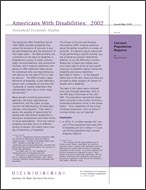Americans With Disabilities: 2002
Americans With Disabilities: 2002
Introduction
The Americans With Disabilities Act of 1990 (ADA) provides guidelines that assure the provision of services to people with disabilities and the protection of their legal rights. The ADA prohibits discrimination on the basis of disability in employment, access to public services, public accommodations, and commercial facilities, and it requires telephone companies to offer telephone relay service for individuals who use telecommunication devices for the deaf (TTYs) or similar devices.1 The ADA includes a legal definition of disability, in part defining a person with a disability as one who has “a physical or mental impairment that substantially limits one or more major life activities.”2
Many groups, including government agencies, advocacy organizations, researchers, and the public at large, monitor the effectiveness of these laws, statutes, and programs. They seek to assess the equality of opportunity for people with and without disabilities in education, employment, and other forms of social participation. Since the various programs and laws focus on different groups of people, this report uses a variety of definitions of disability.3
The Survey of Income and Program Participation (SIPP) contains questions about the ability to perform a number of activities. If a person reports having difficulty performing a specific activity, usually a follow-up question determines whether or not the difficulty is severe. Responses to these and related questions were used to arrive at two overall measures of disability status—nonsevere disability and severe disability—described in Figure 1. In the detailed tables and in the text, these activities are grouped to allow analysis of subsets of people with a disability.
The data in this report were collected from June through September 2002 in the fifth wave (interview) of the 2001 SIPP. The population represented (population universe) is the civilian noninstitutionalized population living in the United States.4 Thus, disabilities of the institutionalized population, such as those in nursing homes, are not reported.
_______________
1 The U.S. Department of Justice maintains a Web site devoted to information about the ADA at <www.ada.gov>. “A Guide to Disability Rights Laws: 2002,” available at that Web site or at <www.usdoj.gov/crt/ada/cguide.htm>, describes the federal laws that specifically address the interests of people with disabilities.
2 See Public Law 101-336, available at <www.usdoj.gov/crt/ada/pubs/ada.txt>.
3 This report is an update of a previous report—P70-73: Americans With Disabilities: 1997, which contained statistical analysis about individuals with disabilities.
4 The estimates in this report (which may be shown in text, figures, and tables) are based on responses from a sample of the population and may differ from the actual values because of sampling variability or other factors. As a result, apparent differences between the estimates for two or more groups may not be statistically significant. All comparative statements have undergone statistical testing and are significant at the 90-percent confidence level unless otherwise noted.
Others in Series
Publication
Publication
Publication




